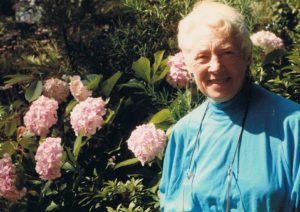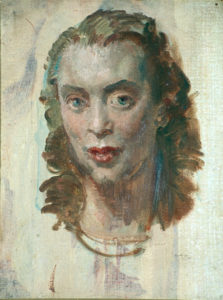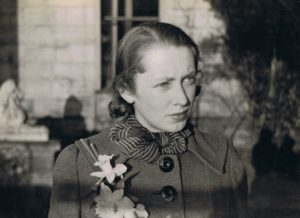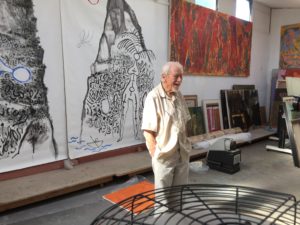Archive for April, 2020
Memories of Ria Murch
Apr 12th
Easter Sunday, 2020, during coronavirus lockdown.
It’s the perfect day to have driven north to visit Ria Murch at Avalon Beach.
A crystalline Autumn morning, with Summer not letting go and the leaves on my plane tree clinging on, still green and luscious.
Every inch of the road to Ria’s place carries me back not only to her, but to where I was born just a few houses down from her place. Over the Sydney Harbour Bridge, through manicured Mosman and down the sweep to the Spit Bridge. Through the Wakehurst Parkway with its wealth of ghost stories. And on to that glorious coast of wild, jutting headlands with profiles like ancient warriors, beautiful and cursed since that day when one of our schoolmates was swept off the rocks and his empty chair in our classroom would be a silent reminder of the ocean’s indifferent power.
Between Newport and Avalon you drive along the Bilgola Bends where the road snakes voluptuously along the coast. The bush tumbles thick and luxurious here, and lantana and salty air make your nostrils flare, wanting more. Ad hoc signs along the verges of the Bends are a local tradition. Welcome home Wazza. Happy 21st Macca. Cheerful reminders that you’re entering the Peninsula. The “insular peninsula” it’s been called. But it didn’t feel like that growing up there. It just felt like the most beautiful place in the world.
After the Bends, you drop down to the left and drive through the Avalon shops. Bill Mitchell’s corner deli still looks the same as it did in the 1970s, although the Italian fruit and vegetable shop in Avalon Parade is many decades gone. The owner Mr Taranto and his son Bob, always immaculately polite, wrapped everything in newspaper for Mum. Searl’s health food store was always a treat, with its glass-fronted wooden drawers full of cashews and pumpkin seeds.
Just a few minutes’ drive out of the village and you’re in Ria’s street. My old street. It’s just the same. The trees are tall and the modest little houses are enfolded in palm trees and bottlebrushes. There’s a famous stand of angophoras in an elbow of the road. Lots of kids lived in the street. In summer we danced about under the sprinkler on the grass out the front of our place. In winter, I remember, I loved seeing my distorted reflection in the concave back of the two-bar heater as Mum dried me down after a bath.
I must have been quite tiny when I first met Ria Murch and her artist husband Arthur. Their kids John and Michelle were too old for me to play with when we were all growing up, although I have since become good friends with Michelle. My parents were friends with the Murches, and Arthur (an Archibald Prize winner) painted my father Neville Fortescue for the 1955 Archibald Prize. The portrait still has pride of place in my home.
Arthur exerted a significant pull on me as a kid, given that he lived in the most extraordinary house. A typical Avalon fibro, it was as much studio as it was home. Half-finished sculptures peeked out of overgrown vines in the garden. A dead funnel web spider in a jar was among the mass of fascinating objects. There were paints and brushes, all in a kind of glorious disorder that immediately spoke to my heart of the wonderful things that were possible in life.
Arthur was always kind to me, teaching me a bit of drawing and, when I was a teenager, allowing me to come to his later studio in Artarmon where he made bread and we ate in happy companionship using newspaper as placemats. I remember Arthur asking whether I liked the sports or the crossword. When I was dropped off to the studio for my visit, a black dog was escaping out the front door with the loaf in his mouth. Arthur, in agitated pursuit, retrieved the bread and brushed it off. No problem. It was delicious.
Arthur died in 1989. By then I had been a journalist for over 10 years, and I wrote quite a few stories about Arthur’s life. More and more, however, my articles came to be about Ria and her quest to honour Arthur’s memory and his extraordinary life in art. She wrote a book about Arthur, and organised an retrospective exhibition of his work at the S.H. Ervin Gallery. She advocated for Arthur’s work, kept his legacy, organised his files, and championed his cause. Whatever she was doing, I always loved writing about it for the paper. (Michelle Murch has taken over the task of managing Arthur’s artistic legacy. Her website is arthurmurch.com)
Ria and I became fast friends. Lunch at her place was a treat, and was something my husband Stephen Gibbes and I always adored. Steve loved Ria, same as I did. You would park the car outside her house, and Ria would always be pottering about in the garden, waiting for you. Or she’d be in the kitchen, making something special. One day we had a gorgeous baked fish with vegetables, followed by baked apples and ice cream. Ria was never happy with her cooking. The fish was always “a bit dry”. But it wasn’t. She was a great cook, and lunch was always delicious.
Ria always had projects on the go. She shared them with you readily. Her epic struggles with her computer were laced with stories about keeping possums out of her roof and memories of Sali Herman’s peacocks straying into her garden and eating her flowers. Ria was never down-beat. Even after a nasty car accident in Avalon, she refused to dwell on her own situation. She always brushed aside her troubles, refusing to indulge them.
But she was a great listener, and loved hearing about what you were doing in your own life. What exhibitions had I seen? What did I think of such and such an artist? When I told her what I was writing about or planning to see, her words were always the same: “You go, girl”. Ria was always encouraging, having been a young journalist herself at one time, when she met Arthur.
She’d tell stories from her early years with Arthur, including how she fell in love with him when he was drawing the Russian ballet dancers at the Theatre Royal in Sydney. A young journalist, Ria was there to write about the touring ballet company. She had an immense knowledge of Australian art and, of course, of Arthur’s practice. It took me many years of listening to her, and reading about the things she told me, before I could get an understanding of what she was talking about. It was pure history. Gradually, I came to understand.
Nothing kept Ria down. She swam at Avalon Beach every morning. I remember her saying she couldn’t “stand” herself until she had done so. She was active in the Avalon community. In short, Ria was an inspiration to me and no doubt to many others. She died in her 90s in 2014. I attended the funeral service at Avalon Bowling Club, which was packed out with oldies, babies, and everyone in between. I made notes (journalists can’t help it) and I must find the shorthand scrawls where I recorded that important event.
It’s on days like this, when the fronds of the palm trees are gleaming in the sun out my window in the Inner West, that the Bilgola Bends beckon. A drive up north to see Ria would have been just wonderful.
Elizabeth Fortescue, April 12, 2020
Guy Warren: a visit to the great Australian artist’s studio
Apr 9th
On March 7, 2016, I was fortunate to visit Guy Warren at his longtime studio in Sydney’s inner suburban Leichhardt.
The purpose for my visit was the story I was writing for the Daily Telegraph about Guy’s upcoming exhibition at the S.H. Ervin Gallery, titled Genesis of a Painter: Guy Warren at 95.
Here’s an edited transcript of our wonderful interview. It seems we started off talking about the Depression era.
Guy Warren: My memory of Sydney in those days was a muso on every street corner busking for a living. And the Manly ferries had musos on them. Each Manly ferry had a piano on board, so there was a pianist, there was usually a violinist, or a banjo player. Or a cornet or something like that. And someone used to take the hat around before they got to Manly. It was a tough life.
I asked Guy how the S.H. Ervin Gallery exhibition had come about.
You know Barry Pearce [emeritus curator of the Art Gallery of NSW]? It’s all Barry’s fault. At a dinner one night I was sitting next to Barry and I said ‘well the major problem I’ve got now is deciding what to keep and what to chuck out. I can’t leave a lot of rubbish behind me. I can’t leave it to the kids, they won’t know. So I’d better decide what to keep and what to chuck out’, and he said ‘oh I’ll come and help you’. So he came and he started pulling things out from that corner over there and he kept saying things like, ‘oh, these are great, oh, these can’t be chucked out, oh, I’ve never seen these before. Have these ever been shown?’ He said, ‘for the first time I can see where you’ve come from. I could see the connection between then and now’. So he thought having a show called Then and Now, so it will be old works and new works. So it’s not a retrospective because there’s nothing in the middle. It’s just then and now. I think it’s a great idea. Because he hopes, and I do too, that people can see the visual connections and the conceptual connections. Ideas that link through and images that link through.
Were you going to throw away some of the ones Barry liked?
They could very well have been. Some I haven’t seen for 60 years. There are things here that are done in the mid 50s.
We discussed Guy’s routine, and he told me he gets into the studio about 10am and works until 6pm or 7pm.
That’s the best days. There are days when it’s not so good and I leave earlier.
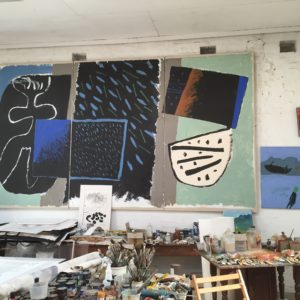
A corner of Guy Warren’s studio. Picture: Elizabeth Fortescue
I explained that the story angle I had in mind was how art keeps you young.
Well I’m not sure it’s art that keeps you young, it’s curiosity I’ve decided. And I think that probably applies to just about everybody. You’re curious to see what’s around the corner. That must be the thing that keeps a scientist going. Wonder what would happen if I do this. I wonder if I can solve that problem by doing this.
Artists are enormously curious, I said to Guy.
Well you never know what the painting’s going to look like until you do it. You might think you’re going to know, you might think you’ve got an idea, but you don’t know until you’ve done it. I remember one eminent American painter, Philip Guston I think, who talks about much the same sort of thing because he never knew what was going to happen until he did it and he said oh that’s what it looks like. And that’s exactly it.
Not everybody works the same way, but if I have an idea it may or may not end up looking like that idea because it’s a conversation you have been you and the painting. Sometimes the painting speaks to you and says, do this. Musicians do the same.
I reminded Guy of his travels to Ecuador in 2013, and suggested it was curiosity that took him there.
I did it because I had a friend [artist Charles Reddington] over there and he invited me over there. My son [Paul] and I went over there. I’d never been to South America before. The Andes, it was fantastic.
What did you do in Ecuador?
I like rainforest country so I went to a place called Cloud Forest which is like rainforest but very high which was extraordinary. Much the same plants that we have here in our rainforest, but twice the size, three times the size. And we ended up in the Galapagos. That was fun. Lots of huge tortoises. The oldest one had recently died. I think they called him Old George. Notices were pinned in all sorts of places, sometimes on trees, which said, you know, goodbye Old George. So he was obviously very popular with tourists, I guess.
Did you do any drawing?
Yes I always carry sketchbooks with me, and I’ve done some paintings since then. (Probably not going in the show.) Not quite relevant to what Barry sees as the main theme of the show.
I’ve been to London and Berlin but that was when my wife was alive. The trouble with getting old is that those things that happened a few years ago, you always think was about two years ago, as a matter of fact when you look it up you find it’s 10 or 20. Time just collapses.
In your wife Joy you had a great mate to be curious with.
Yes, she was. She was a very good ceramicist. That girl got her PhD in her 70s. That’s pretty good, isn’t it. I think it’s bloody amazing. I guess she was curious, she had to be. She had a very good teaching career. She was a damn good ceramicist, too. Made beautiful pots.
Where was her studio?
At home, under the house. The house we bought many years ago had a bit of an area underneath and I borrowed a jackhammer and jackhammered the rock out and she carried it out on a wheelbarrow. It was a joint activity and we made a nice little pottery for her.
I do have another studio at home, not as big as this, but I do a lot of work there. A lot of drawing, sketching, a lot of watercolours.
We discussed how long Guy had been in his Leichhardt studio. He had been in it for 30 years. Before that his studio was an old boat repair shop in the last street on your left as you head towards the end of Darling St, Balmain. Guy was there for almost 10 years while he was also teaching at Sydney College of the Arts. He’d be teaching at the SCA campus then go to the waterfront studio at lunchtime to do a bit of work on a watercolour or something, then return to the SCA for the afternoon sessions.
You had a long teaching career. Did it help keep you going?
I think so, because you’re dealing with ideas. I taught for a long time in the architecture faculty and Sydney University and at the Tin Sheds, and you’re dealing with people who had fantastic information and knowledge about all sorts of things. Teaching is great when you’re learning at the same time. If you can learn as much as you teach, I think it’s marvellous.
It’s stimulating to be among other artists?
Yes, some of my life I had to get other jobs in commerce but most artists do. Certainly in my generation because other jobs weren’t available in those days. Even Lloyd Rees worked in commerce for a long time. I taught with him at Sydney University. I remember him saying the first day that I started teaching with him. He looked at me seriously and he said, ‘Guy if you have ever worked in commerce as I know you have, and as indeed I have in the past, there will come a time as a teacher when you may think you’re not earning your money’. He said, ‘don’t let it worry you’. Then he went on to say that a lot of the teaching takes place in other activities, when you’re talking to students. You know, you don’t have to be teaching. Teaching is about talking to people and discussing ideas, and I think that is what he was talking about. Because Lloyd was that sort of bloke. He was a people person. He welcomed talking to people.
I wouldn’t have been teaching without Lloyd. I bumped into him going home on the bus one night and he asked me would I like to come and help him teach the architecture students. I think he was teaching them drawing. And I was working with an advertising agency at the time, and I thought, hell, it’s a lot better than that.
What were you doing at the ad agency?
A non creative job. I deliberately asked for a non creative job. I’d been away from Australia for eight years. And when I came home I did not want to get into commercial art because it makes you slick and makes you think in a particular way. Worrying about other people’s problems and trying to satisfy the client instead of trying to satisfy yourself. (He had an organising job, organising ads for Nestle and Victa mowers among other things.) I think I’ve probably tried to forget them, but I remember those two. (Guy said he commissioned photographers and artists to do work, and was responsible for everything being done properly. It was a visual job, but not a creative one.) I stayed there for a few years until I started teaching with Lloyd.
In your life, have you done a lot of travel?
I’ve been to Europe a few times and I lived in London for eight years and did a lot of travel while I was there. I hadn’t travelled much in Australia. I’d been to New Guinea of course. And I hitchhiked around Australia with a friend.
David Attenborough had once bought one of Guy’s paintings and I asked if he had ever been in touch with Attenborough again.
Oh yes, I have. The last time was because I saw an interview Andrew Denton. Denton did the interview in [Attenborough’s] lounge room and there was my painting on the wall.
That was probably the time I rang Attenborough over something and asked him how he was going on, and he said, ‘oh, not too bad, not too bad, it is getting a little more difficult to climb trees’. He must have been 80 then. It’s about having a passion and curiosity.
I asked a question about whether art can be a good thing for people when they retire (don’t forget that my story angle was about how art can keep you young). Guy snorted!
Retirement is a stupid bloody word. People think that means they sit on their backsides and don’t do anything. That’s probably the first time in their lives when they have the opportunity to do what they want to do. The word retirement ought to be banned. I refuse to retire.
They say that to me. They say that to every artist. Are you still painting? As though it’s something you can drop. Of course I am, I mean what would I do? It keeps me off the streets.
Can art have a role in people’s lives after work?
I guess it can, but they have to be interested enough to want to do it. And that’s the only problem. I remember talking to somebody once who was CEO of a major international company and he said, ‘oh gee, you’re lucky being a painter. Never mind, when I retire I’m going to learn the flute or the oboe or something’. And I thought, ‘well that would be a great idea, but you can’t leave it too long because you need to start that earlier’. But certainly you don’t have to make art if you don’t want to. But you can learn about art. You can go to plenty of lectures. But people do other things. I’m sure they go to lectures about theatre or science or music.
Your S.H. Ervin exhibition is called Guy Warren at 95: Genesis of a Painter. It includes works from the 1950s and 1960s, as well as contemporary works.
He (Barry Pearce) said I can see for the first time where you’ve come from, and he meant not only the images but the ideas as well. And that was a nice thing to say. The other thing that happens is the concept frequently remains the same but you might try it in a different way, so the envelope might change but the contents are clearly related, and that’s something people might see in this show.
What are the most recent things in the show?
Things I showed with Olsen Irwin last year. An odd collection of paintings and I called them Dust of Memory because that’s what they were. But they’re all new paintings.
Barry Pearce sourced all the older works from Guy’s studio. Some of the pictures were still there, and I noticed that one of them had a post-it note stuck to it, saying ‘Guy to clean’. I asked Guy if the older works had required conservation or anything.
I’ve refurbished some of them but not all and I refuse to have them reframed. If they’re old works then maybe they should be seen in their old frames.
Guy said the journalist Scott Bevan was doing an interview with him to be screened in the gallery at the exhibition.
He did an interview with me years ago, well when I was 90, I think. Five years ago. My god!
Posted by Elizabeth Fortescue, April 9, 2020

